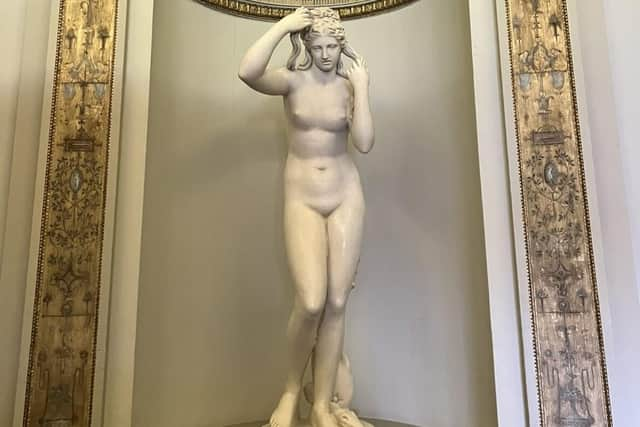Marine Venus returns to Stowe House after a 175-year absence
and live on Freeview channel 276
The original Roman statue was excavated and brought back from the Baths of Caracalla in Rome by the 1st Duke of Buckingham and Chandos, while on his Grand Tour in 1827. He had it restored (it is still possible to see these repairs on the original) – and probably had the top of the niche painted with a shell (Venus’s symbol) especially to frame her. She is shown nude, arranging her hair with a dolphin behind her leg.
When Queen Victoria and Prince Albert visited the house for three days in January 1845, the Queen noticed the piece and she and Albert took a liking to it. The family at Stowe were debt-ridden after years of extravagant purchasing of furnishings, decorating and developing their extensive house and garden in their journey of social and political ambition.
Advertisement
Hide AdAdvertisement
Hide AdWhen the 2nd Duke was forced to put the contents of the Stowe estate up for sale in 1848, the Queen remembered the Music Room Venus and had her German steward bid for it as a surprise birthday present for Albert – he managed to buy it for 156 guineas.


Spotted at the sale, the news hit the headlines quickly and it was in the morning papers before Victoria had the chance to surprise Albert – most amusingly, it was incorrectly reported that Albert had purchased the item which led to much confusion.
It went to Osbourne House, the Royal seaside residence on the Isle of Wight. There, Victoria and Albert designed a niche to display her in the Grand Corridor.
When the Queen died in 1901, it was moved to Windsor Castle and then to Hampton Court in the 1960s. She was returned to Osbourne House in 1981, where she has been ever since.
Advertisement
Hide AdAdvertisement
Hide AdWith a donation gifted to enable the project to begin, experts at Cliveden Conservation were tasked with creating a copy. Assisted with the kind permission of the Royal Collection Trust, the process involved undertaking a 3D laser and photogrammetric scan of the original statue at Osbourne House.
From the 3D scan data, a full-sized SLA print was made to create a silicone rubber mould which could be used to produce a cast in solid Jesmondite. The cast was patinated with pigmented Renaissance wax to resemble marble. Her repairs undertaken by the 1st Duke haven’t been copied across as it was a copy that was made, not a replica.
René Rice, Head of Project Development for Cliveden Conservation explains –
‘It has been a delight to work with Stowe House Preservation Trust in achieving the long-awaited return of a copy of the statue of the Marine Venus – the original of which was lost to the house’s collection in the sale of 1848 where it was bought for the Royal Collection by Queen Victoria’s agent Ludwig Gruner.’
Advertisement
Hide AdAdvertisement
Hide AdAnna McEvoy, House Custodian for Stowe House Preservation Trust shares –
‘There is always a little moment of celebration when an artefact ‘comes’ home, even if it’s a copy. The statue certainly looks comfortable in the niche and the painted curved coving suddenly made more sense once Venus was installed. Thank you to René and his team who, as always, have done a splendid job.’
Visit Stowe House over the Christmas season to see this latest addition to the Music Room. It is open for tours and to explore at your own pace during winter weekends, 11am-3.30pm, every day between 27th December and 1st January, and weekends from 6th January onwards. Purchase admission tickets online to save time, and to arrange parking close to the House. For more information, please check www.stowehouse.org. Adult: £9.50, National Trust Member: £7.50, Children under 16 go free with a paying adult.
The Stowe House Preservation Trust is an independent charity and depends on visitor income and donations to fund restoration work. Please speak to a member of the team or visit the website to find out more about how you can support us.